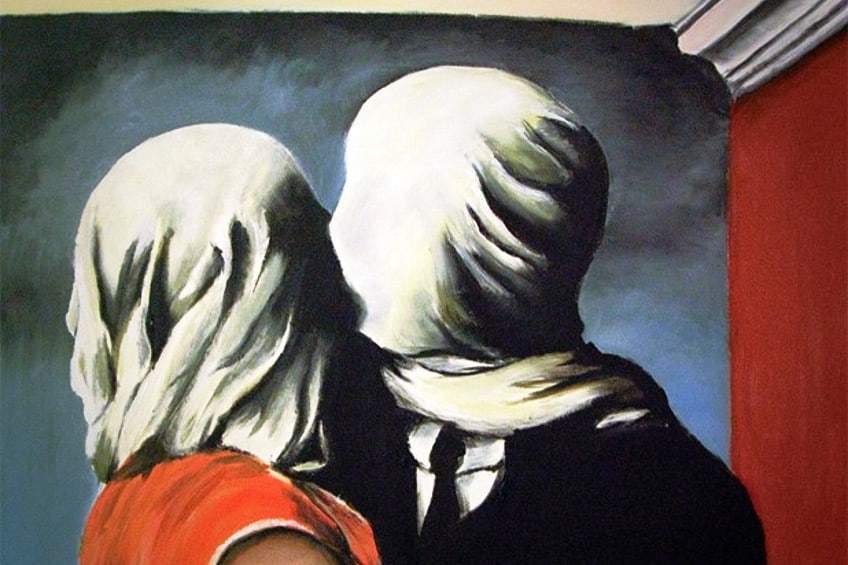“Les Amants” by René Magritte – Discover “The Lovers” Painting
The Surrealist artists of the 20th century visualized new and extraordinary worlds in their art; the worlds of dreams. This article will discuss one such artist, René Magritte, and his series of paintings titled The Lovers (Les Amants) (1928).
Table of Contents
Artist Abstract: Who Was René Magritte?
The Belgian painter René François Ghislain Magritte was born on November 21, 1898, and died on August 15, 1967. He was from the city of Lessines in Hainaut, Belgium. His upbringing was fraught with his mother’s suicide when he was in his early teenage years, and he was reportedly also raised by his grandmother.
He was known as a Surrealist artist but also started his painting career exploring styles like Impressionism, Cubism, and Futurism.

He studied at institutions like the Académie Royale des Beaux-Arts and became a leading influence on future art styles like Pop Art. Some of his artworks include his famous The Treachery of Images (1929) and The Son of Man (1964).
Les Amants (The Lovers) (1928) by René Magritte in Context
| Artist | René Magritte |
| Date Painted | 1928 |
| Medium | Oil on canvas |
| Genre | Symbolic |
| Period/Movement | Surrealism |
| Dimensions (cm) | 54 x 73.4 |
| Series/Versions | Part of four versions of Les Amants |
| Where Is It Housed? | Museum of Modern Art, New York City, United States |
| What It Is Worth | Acquired from a bequest of Richard S. Zeisler |
Les Amants (The Lovers) by René Magritte is a series of four paintings, each depicting a couple from a different angle. This article will discuss the series in more detail in the contextual analysis below, which will be followed by a formal analysis looking at one example from the series, namely The Lovers I, which is held at the Museum of Modern Art in New York City.
Contextual Analysis: A Brief Socio-Historical Overview
Les Amants by René Magritte were all painted in 1928. The first version is held at the Museum of Modern Art in New York City, which depicts the lovers kissing with a piece of fabric over their heads. The second version, The Lovers II, is held at the National Gallery of Australia in Canberra, which depicts a couple standing next to one another, facing us, the viewers, again sporting the white fabric over their heads. The background depicted appears as a natural environment/landscape.
“The Lovers III” is reportedly part of a private collection but shows the couple’s faces, however, the man to our (the viewers’) left does not have any other body parts other than his head, which appears to be floating next to the woman, who is to our right.
The man’s left cheek is touching the right side of the woman’s face, and she is depicted from her shoulders, neck, and head. Her gaze is directed at the man’s head, and she appears in a state of love. Here the background appears as a vast open landscape, which appears to be a natural environment. The two figures also appear elevated with their backs to the background scenery. In the final version, The Lovers IV, René Magritte depicts the couple kissing and both their faces are visible. The man is again depicted as just a head to our (the viewers) right and the woman is to our left.
She is in a somewhat reclining position on a rocky surface. Her entire body is in view except for her feet, which are cut off by the canvas frame. She is wearing a red dress. The background is set in an unusual rocky and mountainous region.
Formal Analysis: A Brief Compositional Overview
The formal analysis below will discuss the first painting of the series Les Amants by René Magritte in more detail starting with a visual description of the subject matter, unveiling what the artist was portraying, and followed by a look at how the art elements are utilized within the composition.
Subject Matter: Visual Description
In Les Amants (The Lovers), René Magritte depicts a couple kissing, however, this is no ordinary kiss. The couple, the woman to the left and the man to the right, both have a white piece of fabric covering their entire heads, from just below their necks; the excess of the fabric is draped behind their shoulders, concealing both their faces.
The subtle tightness of it over their faces leaves traces of their facial features like the tips of their noses and the indentation of where their eyes are.
Their mouths are locked in a kiss, but the kiss is covered up. The woman to the left appears to be wearing a red sleeveless blouse (or dress) with thin white trimmings along the edges of the sleeves and collar area. The man to the right is wearing a black suit; underneath his suit is a white shirt and black tie. They both appear to be standing in profile, which means we, the viewers, can see them from their side.
Furthermore, only their upper torsos and heads are in view, revealing the upper part of the woman’s right arm. The man’s body is slightly turned to the frontal view. The woman is slightly shorter in height than the man, and her head is tilted upwards as the man sinks ever so slightly to meet her with a kiss. The surrounding environment appears to be an interior setting. The ceiling appears white, the right wall appears red, and the back wall in our direct line of sight appears black/dark gray, somewhat resembling a stormy and dark sky.
There is a white cornice to the right, linking the right wall with the ceiling, however, there is no cornice in the direct background that links the ceiling with the wall.
Color
René Magritte utilized a limited color palette in Les Amants (The Lovers), most notably blacks, reds, and whites. For example, notice how the red of the woman’s dress is echoed in the red of the wall to the right. The black of the man’s suit is similarly echoed by the darker bluish-gray/black of the wall in the background. There are also shadows and highlights utilized notably on the white fabric over the couple’s heads.
This creates a contrast between light and dark.
Texture
The soft and draped texture of the fabric around the couple’s heads in Les Amants (The Lovers) by René Magritte is implied through coloring and contrasts of light and dark. Furthermore, another type of texture is evident from the brushstrokes on the canvas, which appear smooth on the canvas’s surface.
Line
In René Magritte’s Les Amants (The Lovers) there are various types of lines, namely curved lines of the couple’s heads, which is even more outlined from the white fabric over their head. The curvier lines are contrasted by the straight vertical and horizontal lines from the wall and cornice in the background. Additionally, implied lines are indicated by the folds of the fabric as well as the fabric that makes the clothing.
Directional lines are evident by the figures as they kiss, the woman’s tilted head and the man turned head while his torso is semi-facing us, the viewers.
Shape and Form
There is a contrast between shape and form in Les Amants (The Lovers) by René Magritte, for example, the organic (naturalistic) forms of the two figures in the foreground are set against the more geometric shape of the wall and cornice in the background. The latter seemingly creates a square-like shape as the ceiling and two walls connect. Additionally, there is a circular shape created by the figures’ heads.
Space
The two figures occupy the immediate foreground. They appear from a close-up angle as if we, the viewers, can touch them. The wall in the background seemingly creates a backdrop effect, as if framing the couple. However, questions arise as to what the background wall is that Magritte depicted and if it is in fact a wall or possibly a view.
Interestingly, René Magritte’s spatial composition in Les Amants (The Lovers) has been connected to his interest in cinematography as if the lovers are being framed by a camera lens.
Unveiling Magritte
The series of four paintings titled Les Amants (The Lovers) by René Magritte are unique in their depiction of two lovers, posed differently in each painting with backgrounds that are seemingly random and unrecognizable, as if they are in a different world altogether, or a cinematic world.

This article explored the first version of “The Lovers” painting in more detail, discussing how the art elements make up the piece. Although there are many questions raised by Magritte’s mysterious couple, it is nonetheless an unveiling of the artist’s skill and imagination, and as many scholars have questioned, a reference to his past and subconscious.
Take a look at our Les Amants painting webstory here!
Frequently Asked Questions
Who Painted The Lovers?
The Lovers painting, also titled Les Amants (1928), was painted by the Surrealist painter René Magritte. It is a series of four oil paintings each held in different art collections and museums. The four paintings were all painted during 1928 when the artist lived in Paris.
How Many Les Amants Paintings Are There?
There are four paintings titled Les Amants (The Lovers) (1928) by René Magritte, which were all painted during the same year. The paintings are held in different art institutions, namely with The Lovers at the Museum of Modern Art in New York City, The Lovers II at the National Gallery of Australia in Canberra, and The Lovers III and The Lovers IV in a private collection.
What Is the Meaning of the Les Amants Painting?
There are several interpretations of Les Amants (The Lovers) (1928) by René Magritte and many point to the artist’s past and his mother’s suicide. However, it also includes ideas of the invisible, which were based on explorations by the Surrealist artists.
Alicia du Plessis is a multidisciplinary writer. She completed her Bachelor of Arts degree, majoring in Art History and Classical Civilization, as well as two Honors, namely, in Art History and Education and Development, at the University of KwaZulu-Natal, South Africa. For her main Honors project in Art History, she explored perceptions of the San Bushmen’s identity and the concept of the “Other”. She has also looked at the use of photography in art and how it has been used to portray people’s lives.
Alicia’s other areas of interest in Art History include the process of writing about Art History and how to analyze paintings. Some of her favorite art movements include Impressionism and German Expressionism. She is yet to complete her Masters in Art History (she would like to do this abroad in Europe) having given it some time to first develop more professional experience with the interest to one day lecture it too.
Alicia has been working for artincontext.com since 2021 as an author and art history expert. She has specialized in painting analysis and is covering most of our painting analysis.
Learn more about Alicia du Plessis and the Art in Context Team.
Cite this Article
Alicia, du Plessis, ““Les Amants” by René Magritte – Discover “The Lovers” Painting.” Art in Context. June 2, 2023. URL: https://artincontext.org/les-amants-by-rene-magritte/
du Plessis, A. (2023, 2 June). “Les Amants” by René Magritte – Discover “The Lovers” Painting. Art in Context. https://artincontext.org/les-amants-by-rene-magritte/
du Plessis, Alicia. ““Les Amants” by René Magritte – Discover “The Lovers” Painting.” Art in Context, June 2, 2023. https://artincontext.org/les-amants-by-rene-magritte/.











